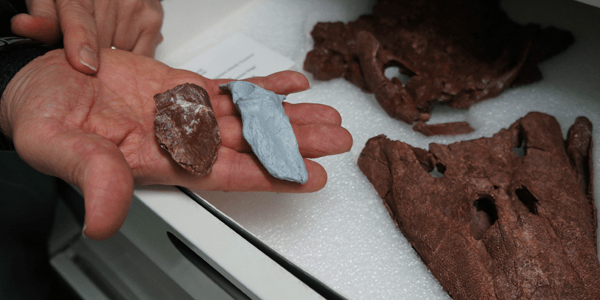Fossil Find Shows Fish Hips Grew Strong Before Life's First Steps
 By Rachel Ewing
By Rachel Ewing

- Drexel Selects New, World-Class Life Sciences Building at 3201 Cuthbert Street for Medical Research Operations
- Breakthrough on Gene Therapy for Hereditary Spastic Paraplegia
- Drexel Environmental Collaboratory Releases Cross-Sector Findings on Severe Weather Recovery Challenges
- Drexel Launches the Manuel Stamatakis Center for Alternative Investments at the LeBow College of Business

The discovery of new fossil materials from the ancient fish species Tiktaalik roseae has revealed a key link in the evolution of hind limbs. The newly described, well-preserved pelves and partial pelvic fin from this 375 million-year-old transitional species between fish and the first legged animals, reveals that the evolution of hind legs actually began as enhanced hind fins. This challenges existing theory that large, mobile hind appendages were developed only after vertebrates transitioned to land. The team of scientists describes these findings in the Proceedings of the National Academy of Sciences, online on Jan. 13.
The prevailing scientific understanding of how vertebrates transitioned from movement powered by fins, to movement powered by limbs, is based on “a ‘front-wheel drive’ idea that these animals were primarily using their front limbs for locomotion. Hind limbs were small and not particularly involved in new patterns of movement,” said Ted Daeschler, PhD, vice president for collections and associate curator of vertebrate zoology at the Academy of Natural Sciences of Drexel University, a co-author of the study.
“But it looks like this shift actually began to happen in fish, not in limbed animals,” said co-author Neil Shubin, PhD, a professor at the University of Chicago.
A lobe-finned fish with a broad flat head and sharp teeth, Tiktaalik roseae looked like a cross between a fish and a crocodile, growing up to a length of 9 feet as it hunted in shallow freshwater environments. It had gills, scales and fins, but also had tetrapod-like features such as a mobile neck, robust ribcage and primitive lungs.
In particular, its large forefins had shoulders, elbows and partial wrists, which allowed it to support itself on ground. These features make it one of the best-known transitional species between fish and land-dwelling tetrapods.
Tiktaalik was discovered in 2004 by a team including Shubin and Daeschler, who is now also an associate professor of Biodiversity, Earth and Environmental Science at Drexel University, and the late Farish A. Jenkins, Jr., PhD, of Harvard University.
However, only specimen blocks containing the front portion of Tiktaalik have been described thus far. As the researchers investigated additional blocks recovered from their original and subsequent expeditions to the dig site in northern Canada, they discovered the rear portion of Tiktaalik, which contained the pelves as well as partial pelvic fin material. The fossils included the complete pelvis of the original ‘type’ specimen, making a direct comparison of the front and rear appendages of a single animal possible.
The scientists were immediately struck by the pelvis, which was comparable to those of some early tetrapods. The Tiktaalik pelvic girdle was nearly identical in size to its shoulder girdle, a tetrapod-like characteristic. It possessed a prominent ball and socket hip joint, which connected to a highly mobile femur that could extend beneath the body. Crests on the hip for muscle attachment indicated strength and advanced fin function. And although no femur bone was found, pelvic fin material, including long fin rays, indicated the hind fin was at least as long and as complex as its forefin.
“This is an amazing pelvis, particularly the hip socket, which is very different from anything that we knew of in the lineage leading up to limbed vertebrates,” Daeschler said. “Tiktaalik was a combination of primitive and advanced features. Here, not only were the features distinct, but they suggest an advanced function. They appear to have used the fin in a way that’s more suggestive of the way a limb gets used.”
Tiktaalik pelves were still clearly fish-like, with primitive features such as an undivided skeletal configuration, as opposed to the three-part pelvic girdle of early tetrapods. However, the expanded size, mobility and robusticity of the pelvic girdle, hip joint and fin of Tiktaalik made a wide range of motor behaviors possible.
“It’s reasonable to suppose with those big fin rays that Tiktaalik used its hind fins to swim like a paddle,” Shubin said. “But it’s possible it could walk with them as well. African lungfish living today have similarly large pelves, and we showed in 2011 that they walk underwater on the bottom.” (For a video of a walking lungfish see: http://www.uchospitals.edu/news/2011/20111212-lungfish.html).
“Regardless of the gait Tiktaalik used, it’s clear that the emphasis on hind appendages and pelvic-propelled locomotion is a trend that began in fish, and was later exaggerated during the origin of tetrapods,” Shubin said.
Learn more about Tiktaalik and the evolution of limbed animals
A three-part TV series based on Shubin’s book “Your Inner Fish,” hosted by Shubin and featuring the Tiktaalik study team including Daeschler, will air on PBS in April 2014, tracing the origins of the human body through the DNA of living animals and the legacies of now-extinct, but biologically important species such as Tiktaalik roseae.
The televised documentary “Rise of Animals: Triumph of the Vertebrates,” hosted by David Attenborough, which aired on BBC2 in the UK in 2013 and may air in the U.S. later in 2014, featured Daeschler and the discovery of Tiktaalik.
[iframe src="//player.vimeo.com/video/74863166" width="600" height="337" frameborder="0" webkitallowfullscreen mozallowfullscreen allowfullscreen]
Casts of Tiktaalik roseae are on permanent display at the Academy of Natural Sciences of Drexel University in Philadelphia and at the Field Museum in Chicago.
Note to news media: The press contact for the University of Chicago is Kevin Jiang, kevin.jiang@uchospitals.edu. This press release was adapted with permission from materials prepared by Jiang for the University of Chicago.
Drexel News is produced by
University Marketing and Communications.